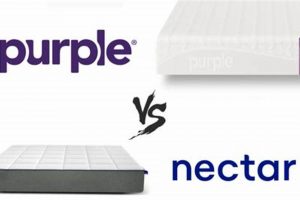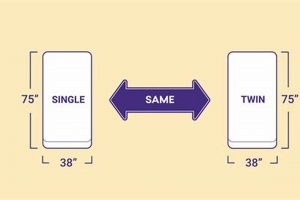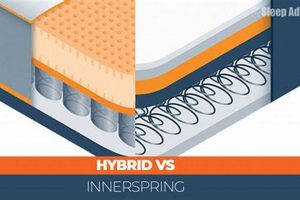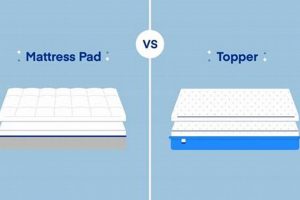The selection of a sleep surface significantly impacts rest quality and overall well-being. Two prevalent construction types dominate the market, each offering distinct characteristics: innerspring models and those constructed from various densities of synthetic materials. These two types cater to a range of preferences and physical needs.
The importance of understanding the nuances between these options lies in optimizing sleep comfort and supporting proper spinal alignment. Historically, innerspring designs were the standard, evolving from simple arrangements to complex, individually pocketed spring systems. Synthetic alternatives, meanwhile, represent more recent technological advancements in material science, offering unique properties related to pressure relief and motion isolation. The advantages of each have been continuously refined.
The subsequent discussion will explore the construction, support characteristics, motion transfer, temperature regulation, durability, and cost considerations of these two mattress types. This comprehensive overview will provide the information needed to make an informed decision based on individual requirements.
Guidance on Mattress Selection
Selecting a mattress requires careful consideration of individual sleep preferences and physical needs. The following guidelines address key factors when evaluating different mattress types.
Tip 1: Assess Support Needs: Consider body weight and preferred sleep position. Heavier individuals or those who sleep on their stomach may require firmer support, commonly found in innerspring models. Side sleepers may benefit from the conforming support of synthetic materials.
Tip 2: Evaluate Pressure Relief: Individuals with joint pain or pressure point sensitivity should assess the pressure-relieving capabilities. Materials with high density can contour to the body, distributing weight evenly and reducing pressure on sensitive areas.
Tip 3: Consider Motion Isolation: If sharing a bed, motion isolation is a crucial factor. Innerspring models generally transfer more motion than synthetic alternatives. Individually pocketed coils can minimize motion transfer compared to interconnected coil systems.
Tip 4: Temperature Regulation: Consider sleeping temperature preferences. Innerspring mattresses tend to promote airflow, potentially sleeping cooler. However, open-cell synthetic materials are designed to improve breathability and mitigate heat retention.
Tip 5: Evaluate Durability Expectations: The expected lifespan of a mattress varies depending on construction and materials. Innerspring models may experience coil sagging over time. High-density synthetic materials generally offer greater resistance to sagging and indentation.
Tip 6: Research Material Composition: Investigate the specific materials used in the mattress construction. Certifications such as CertiPUR-US indicate that the materials have been tested for harmful substances and meet specific emissions standards.
Tip 7: Check Warranty and Trial Periods: Review the manufacturer’s warranty and any available trial periods. This allows for sufficient time to evaluate comfort and support characteristics before making a final decision.
In summary, understanding support needs, pressure relief requirements, motion isolation preferences, temperature regulation factors, and durability expectations are crucial to making an informed decision.
The subsequent sections will delve into specific brands and models, providing real-world examples and further insights into the selection process.
1. Support and spinal alignment
Proper spinal alignment during sleep is crucial for minimizing back pain, promoting muscle relaxation, and optimizing overall rest quality. The support characteristics of a sleep surface directly influence the degree to which the spine maintains its natural curvature throughout the night. Differing construction methods offer distinct support profiles, impacting spinal health differently.
Innerspring mattresses, with their coil-based support systems, generally provide a firmer, more uniform level of support. This can be advantageous for individuals who require consistent spinal stabilization, such as stomach sleepers or those with specific orthopedic needs. For example, a person with a history of lower back pain may find the firm, unwavering support of an innerspring mattress helps prevent spinal misalignment and reduces morning stiffness. However, the rigid nature of coil systems may not conform sufficiently to the body’s contours, potentially creating pressure points in areas like the hips and shoulders.
Synthetic material models, such as those constructed from memory foam or latex, offer more conforming support. These materials respond to body weight and temperature, molding to the individual’s unique shape and distributing pressure more evenly. This can be particularly beneficial for side sleepers, who require cushioning to maintain spinal alignment and prevent pressure buildup on the shoulder and hip joints. However, the level of support provided by these materials can vary greatly depending on density and composition. A low-density synthetic surface may compress excessively, leading to spinal misalignment and discomfort, while a high-density version might provide insufficient give, resulting in similar issues. Therefore, careful consideration of material properties is essential.
2. Pressure point relief
Pressure point relief refers to the reduction of concentrated stress on specific areas of the body during sleep, primarily at bony prominences like the hips, shoulders, and spine. In the context of sleep surfaces, pressure points can impede blood circulation, causing discomfort and disrupting sleep. The choice between innerspring and synthetic material construction profoundly affects the degree of pressure relief achieved.
Innerspring models, characterized by their coil-based support systems, traditionally offer less effective pressure relief. The interconnected nature of coils creates a more uniform surface, but can result in concentrated stress on these key areas. Conversely, synthetic material options, particularly memory foam, excel in conforming to the body’s contours, distributing weight more evenly and reducing pressure at sensitive points. For example, an individual with arthritis may experience reduced joint pain and improved sleep quality due to the pressure-relieving properties of a memory foam mattress. However, not all synthetic surfaces perform equally; the density and composition of the material dictate its capacity to alleviate pressure. Low-density synthetic material might compress excessively, negating its pressure-relieving benefits.
In summary, the ability to minimize pressure points is a critical factor when selecting a sleep surface. While innerspring mattresses may offer adequate support for some individuals, synthetic material alternatives, especially those incorporating memory foam or advanced polymer technologies, often provide superior pressure relief, leading to improved comfort and reduced sleep disturbances. Careful consideration of material properties and individual needs is paramount in optimizing sleep quality.
3. Motion isolation efficiency
Motion isolation efficiency, the ability of a sleep surface to minimize the transfer of movement from one area to another, is a critical consideration for individuals sharing a bed. The construction materials and design of a mattress significantly influence its motion isolation capabilities. Understanding these differences is essential for selecting a sleep surface that promotes undisturbed rest.
- Coil System Interconnection
Interconnected coil systems, commonly found in traditional innerspring mattresses, tend to transmit motion more readily. When one partner moves, the connected coils react, causing movement across the entire surface. For example, if one individual gets out of bed, the other may feel a noticeable disturbance due to the interconnected nature of the coils. This interconnectedness reduces motion isolation efficiency.
- Pocketed Coils and Individual Encasement
Pocketed coil systems, where each spring is individually wrapped in fabric, offer improved motion isolation compared to interconnected coils. The individual encasement prevents the transfer of movement across the entire surface. If one partner moves, the motion is largely contained within the individual pocketed coil, minimizing disturbance to the other. This design enhances motion isolation efficiency.
- Synthetic Material Viscoelasticity
Synthetic materials, such as memory foam and latex, exhibit viscoelastic properties that absorb and dampen motion. These materials conform to the body’s shape, isolating movement to the immediate area of impact. The viscoelastic nature of synthetic materials contributes to high motion isolation efficiency, reducing the transfer of motion across the sleep surface.
- Density and Composition of Synthetic Materials
The density and composition of synthetic materials directly impact motion isolation. Higher density materials tend to absorb more motion, while variations in material composition can alter the degree of motion dampening. A high-density memory foam mattress will generally provide superior motion isolation compared to a lower-density option, directly influencing sleep quality.
The choice between innerspring and synthetic material surfaces directly impacts motion isolation. While pocketed coil systems offer improved motion isolation compared to interconnected coils, synthetic materials generally provide the highest levels of motion isolation efficiency, promoting undisturbed sleep for both partners. Consideration of coil design and the properties of synthetic materials is crucial when evaluating the motion isolation capabilities of a sleep surface.
4. Temperature regulation properties
Temperature regulation is a critical component of sleep comfort, influencing the duration and quality of rest. In the context of sleep surfaces, temperature regulation properties refer to the ability of a mattress to dissipate heat and maintain a comfortable sleeping temperature. Differences in construction between innerspring and synthetic material mattresses significantly impact their temperature regulation capabilities, affecting user comfort and sleep quality.
Innerspring mattresses, with their open coil structure, promote airflow, facilitating heat dissipation and preventing excessive heat buildup. The open space between coils allows for continuous air circulation, reducing the likelihood of overheating and maintaining a cooler sleeping surface. For example, individuals prone to night sweats may find innerspring mattresses more comfortable due to their enhanced breathability. Conversely, synthetic material mattresses, particularly those constructed from memory foam, often exhibit reduced airflow due to their dense structure. This can lead to heat retention and a warmer sleeping environment, potentially causing discomfort and sleep disturbances. However, manufacturers are actively developing synthetic materials with enhanced breathability, such as open-cell memory foam and gel-infused foams, to mitigate heat retention and improve temperature regulation properties.
Selection should consider climate, personal preferences, and physiology. Individuals residing in warmer climates may prioritize mattresses with superior airflow and heat dissipation. Furthermore, specific physiological factors, such as hormonal changes or metabolic conditions, can influence body temperature during sleep. Understanding the interplay between construction, temperature regulation, and individual needs is essential to optimize sleep comfort. The continuous refinement of mattress technology seeks to address this dynamic, providing options tailored to the individual.
5. Longevity and durability
The longevity and durability of a mattress are critical factors in determining its overall value and long-term cost-effectiveness. Mattress construction, particularly the choice between coil and synthetic materials, significantly influences its lifespan and resistance to wear. A direct correlation exists between the materials used, the manufacturing processes employed, and the period over which a mattress maintains its support and comfort characteristics. Reduced longevity translates to more frequent replacements, impacting both financial and environmental resources. Consequently, understanding the durability characteristics of different mattress types is paramount in making informed purchase decisions.
Coil mattresses, while offering initial firmness and support, are susceptible to coil fatigue and sagging over time. The continuous compression and decompression of the coils can lead to a gradual loss of springiness and an uneven sleeping surface. For instance, a mattress used by a heavier individual may exhibit noticeable sagging within a few years, requiring premature replacement. Conversely, synthetic material mattresses, particularly those constructed from high-density memory foam or latex, generally exhibit greater resistance to sagging and indentation. The dense cellular structure of these materials allows them to maintain their shape and support characteristics for an extended period. However, the quality of the synthetic materials is paramount; lower-density foams may degrade more quickly, negating their potential durability advantages. Real-world examples include long-term studies documenting the superior resistance to compression and deformation in high-density synthetic mattresses compared to coil-based alternatives over a period of several years. Moreover, proper maintenance, such as rotating or flipping the mattress regularly, can extend its lifespan regardless of construction type.
Ultimately, selecting a mattress requires balancing initial cost with long-term value. While coil mattresses may offer a lower initial price point, their reduced lifespan can result in higher overall costs due to more frequent replacements. Synthetic material mattresses, though potentially more expensive upfront, often provide greater longevity and sustained comfort, potentially offsetting the initial investment. The challenge lies in assessing the quality and density of the materials used, as well as considering individual sleep habits and body weight. Evaluating warranty terms and consulting independent reviews can provide further insights into the long-term durability of a given mattress model, enabling a more informed and cost-effective purchase decision.
Frequently Asked Questions
This section addresses common inquiries regarding the distinctions and suitability of coil and foam mattress constructions.
Question 1: Is a coil mattress inherently firmer than a foam mattress?
While coil mattresses are often perceived as firmer, firmness levels vary significantly within both categories. Coil mattresses achieve firmness through coil gauge and density, while foam mattresses rely on foam density and composition. Comparing firmness requires evaluating specific models rather than generalizing based on construction type alone.
Question 2: Does a foam mattress always sleep hotter than a coil mattress?
Traditional memory foam mattresses have been associated with heat retention due to their dense structure and limited airflow. However, advancements in foam technology, such as open-cell foam and gel infusions, have improved breathability. Coil mattresses generally offer better airflow due to their open structure, but temperature regulation depends on the specific materials and construction of each mattress type.
Question 3: Are coil mattresses more durable than foam mattresses?
Durability depends on material quality and construction. High-quality coil mattresses with tempered steel coils can be highly durable, but are susceptible to sagging over time. High-density foam mattresses can also offer excellent durability, resisting sagging and indentation. Lower-quality materials in either type can result in premature wear and reduced lifespan.
Question 4: Which type of mattress is better for back pain?
The ideal mattress for back pain depends on individual needs and preferences. Firm mattresses may provide better support for some individuals, while others may find pressure relief with conforming foam mattresses. Proper spinal alignment is crucial, and a mattress that conforms to the body while providing adequate support is generally recommended. Consulting with a healthcare professional is advised for specific recommendations.
Question 5: Does a higher coil count always equate to a better coil mattress?
While coil count can be an indicator of support, it is not the sole determinant of quality. Coil gauge (thickness) and type (e.g., pocketed vs. interconnected) also significantly influence support and comfort. A higher coil count with thinner coils may not provide the same level of support as a lower coil count with thicker, sturdier coils.
Question 6: Are foam mattresses hypoallergenic?
Some foam mattresses, particularly those made with latex, are naturally hypoallergenic. However, synthetic foam mattresses may contain materials that can trigger allergies in sensitive individuals. Certifications such as CertiPUR-US indicate that the foam has been tested for harmful substances and may reduce the risk of allergic reactions. Washing mattress protector is always recommended.
In summary, the choice between coil and foam depends on individual preferences and needs. Careful consideration of material quality, construction, and specific features is essential to select the most appropriate sleep surface.
The subsequent section will explore specific brands and models, providing real-world examples and further insights into the selection process.
Coil vs Foam Mattress
The preceding examination of the characteristics, advantages, and disadvantages of coil and foam mattress constructions underscores the importance of informed decision-making in the realm of sleep surfaces. This exploration has illuminated the distinct properties of each type, focusing on support, pressure relief, motion isolation, temperature regulation, and longevity. The complexities inherent in selecting the optimal sleep solution necessitate a thorough understanding of individual needs and preferences, coupled with a critical evaluation of available options.
The decision to adopt a coil or foam configuration should not be approached lightly. It is imperative to meticulously consider the long-term implications of each choice, aligning the selection with individual health requirements and budgetary constraints. Continued advancements in sleep technology promise to further refine the properties of both coil and foam mattresses, offering enhanced comfort and support for generations to come. Prioritizing informed choices will lead to improved sleep quality and overall well-being.







![Bear vs Saatva Mattress: Which Bed is Best [Review]? Organic & Natural Mattress Buyer’s Guide: Non-Toxic Sleep Solutions Bear vs Saatva Mattress: Which Bed is Best [Review]? | Organic & Natural Mattress Buyer’s Guide: Non-Toxic Sleep Solutions](https://mattressworldpa.com/wp-content/uploads/2025/07/th-1052-300x200.jpg)